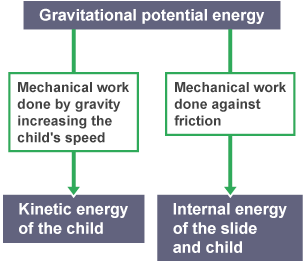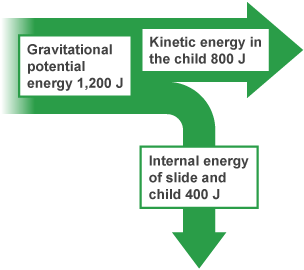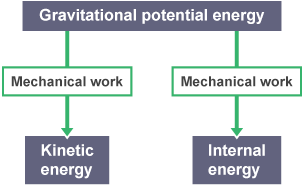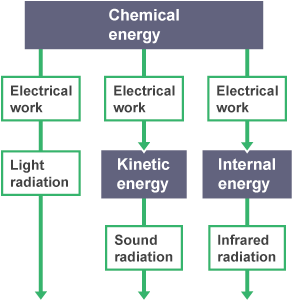energy
There are eight main stores of energy:
- magnetic
- internal (thermal)
- chemical
- kinetic
- electrostatic
- elastic potential
- gravitational potential
- nuclear
Energy store | Description | Examples |
|---|---|---|
Magnetic | The energy stored when repelling poles have been pushed closer together or when attracting poles have been pulled further apart. | Fridge magnets, compasses, maglev trains which use magnetic levitation. |
Internal (thermal) | The total kinetic and potential energy of the particles in an object, in most cases this is the vibrations – also known as the kinetic energy – of particles. In hotter objects, the particles have more internal energy and vibrate faster. | Human bodies, hot coffees, stoves or hobs. Ice particles vibrate slower, but still have energy. |
Chemical | The energy stored in chemical bonds, such as those between molecules. | Foods, muscles, electrical cells. |
Kinetic | The energy of a moving object. | Runners, buses, comets. |
Electrostatic | The energy stored when repelling charges have been moved closer together or when attracting charges have been pulled further apart. | Thunderclouds, Van De Graaff generators. |
Elastic potential | The energy stored when an object is stretched or squashed. | Drawn catapults, compressed springs, inflated balloons. |
Gravitational potential | The energy of an object at height. | Aeroplanes, kites, mugs on a table. |
Nuclear | The energy stored in the nucleus of an atom. | Uranium nuclear power, nuclear reactors. |
Pathways for transferring energy
Energy can be transferred from one store into another - as one store empties, another store fills. The process by which this happens is called the pathway. There are four main pathways:
- mechanical work - a force moving an object through a distance
- electrical work - charges moving due to a potential difference
- heating - due to temperature difference caused electrically or by chemical reaction
- radiation - energy transferred as a wave, eg light and infrared - the Sun emits light radiation and infrared radiation
Systems and stores
Energy can remain in the same store for millions of years or sometimes just for a fraction of a second. There are energy transfers going on all the time - whenever a system changes there is a change in the way some or all of the energy is stored.
Diagrams can be used to show how energy is transferred from one store to another. Two examples are the transfer diagram and the Sankey diagram.
Transfer diagrams
In transfer diagrams the boxes show the energy stores and the arrows show the energy transfers.
For example, a transfer diagram for a child at the top of a slide may be:

Gravitational energy stored in the child at the top of the slide is transferred as mechanical work done to speed up and to do work against friction. The result of this is a shift of energy from the gravitational potential energy store to the kinetic energy store and the internal energy store (raising the temperature of the child and the slide).
Sankey diagrams
Sankey diagrams start off as one arrow that splits into two or more points. This shows how all the energy in a system is transferred into different stores.

Sankey diagrams are really useful when the amount of energy in each of the energy sources is known. The width of the arrow is drawn to scale to show the amount of energy.
The conservation of energy
Energy can be transferred usefully, stored or dissipated, but it cannot be created or destroyed.
In all cases, energy comes from one store and is transferred to another store. This means that all the energy in the universe was present at the Big Bang and will still be around at the very end of time.
Examples of conservation of energy
The skydiver
When a skydiver jumps out of a plane, he begins to lose energy from the gravitational potential energy store as his height decreases, and his kinetic energy store increases as his speed increases.

However, not all of the energy lost from the gravitational potential energy store is transferred into the kinetic energy store. As some work is done pushing against the air particles, some of the gravitational potential energy is transferred to the air particles and is stored as internal energy.
Smartphones
All smartphones contain a battery that stores chemical energy. When a smartphone is in use, the battery's chemical energy store decreases. The energy is transferred via the electrical work pathway to light the screen and produce sound.
The light that comes from a smartphone is emitted via the light radiation pathway, and the sound waves are produced by a speaker that vibrates back and forth and are emitted via the sound radiation pathway. Eventually both the light and the sound pathways lead to (very small) increases in the internal energy store (temperature) of the surroundings.
In addition to this, many smartphones also heat up when used, so energy from the chemical store is also transferred to the internal energy store. This causes an increase in the temperature of the phone and causes it to emit more energy via the infrared radiation pathway.

The amount of gravitational potential energy stored by an object at height can be calculated using the equation:
change in gravitational potential energy = mass x gravitational field strength x change in vertical height
Δ𝐺𝑃𝐸=𝑚×𝑔×Δℎ
This is when:
- change in gravitational potential energy (ΔGPE) is measured in joules (J)
- mass (m) is measured in kilograms (kg)
- gravitational field strength (g) is measured in newtons per kilogram (N/kg)
- change in vertical height (Δh) is measured in metres (m)